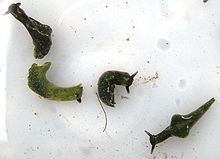Elysia viridis
 From Wikipedia the free encyclopedia
From Wikipedia the free encyclopedia
| Sap-sucking slug | |
|---|---|
 | |
| A live individual of Elysia viridis on brown algae. | |
 | |
| Four live individuals of Elysia viridis | |
| Scientific classification | |
| Domain: | Eukaryota |
| Kingdom: | Animalia |
| Phylum: | Mollusca |
| Class: | Gastropoda |
| Subclass: | Heterobranchia |
| Family: | Plakobranchidae |
| Genus: | Elysia |
| Species: | E. viridis |
| Binomial name | |
| Elysia viridis (Montagu, 1804) | |
Elysia viridis, the sap-sucking slug, is a small-to-medium-sized species of green sea slug, a marine opisthobranch gastropod mollusc in the family Plakobranchidae.
This sea slug resembles a nudibranch, but it is not closely related to that clade of gastropods. It is instead a sacoglossan.
Distribution[edit]
This species lives in the northeastern Atlantic, from Norway to the Mediterranean Sea as well as all around the South African coast. It is found from the intertidal zone to a depth of about 5 m.
Description[edit]
The animal grows up to 30 mm in total length. It has a smooth bright green or brown body with iridescent spots and two wing-like flaps extending along its sides. These flaps are usually folded back. The rhinophores are rolled.[1]
Ecology[edit]
This species lives in a subcellular endosymbiotic relationship with chloroplasts derived from the alga Codium fragile. These chloroplasts provide the Elysia host with the products of photosynthesis.[2][3][4] Elysia viridis feeds on Codium, and absorbs its chloroplasts. The term for such an activity is kleptoplasty. The slug retains the chloroplasts within its cells in a functioning state; they apparently are physiologically important to the host. In addition, the slugs likely rely on photosynthesis of the chloroplasts as an energy source, especially when other food sources are not available.[5]
The egg mass is a flat greenish coil of several turns.[6]
See also[edit]
References[edit]
- ^ Zsilavecz, G. (2007). Nudibranchs of the Cape Peninsula and False Bay. ISBN 0-620-38054-3
- ^ R.K. Trench; J.E. Boyle & D.C. Smith (1973). "The Association between Chloroplasts of Codium fragile and the Mollusc Elysia viridis. I. Characteristics of isolated Codium chloroplasts". Proceedings of the Royal Society of London. Series B, Biological Sciences. 184 (1074): 51–61. doi:10.1098/rspb.1973.0030.[permanent dead link]
- ^ R.K. Trench; J.E. Boyle & D.C. Smith (1973). "The Association between Chloroplasts of Codium fragile and the Mollusc Elysia viridis. II. Chloroplast Ultrastructure and Photosynthetic Carbon Fixation in E. viridis". Proceedings of the Royal Society of London. Series B, Biological Sciences. 184 (1074): 63–81. doi:10.1098/rspb.1973.0031.[permanent dead link]
- ^ R.K. Trench; J.E. Boyle & D.C. Smith (1974). "The Association between Chloroplasts of Codium Fragile and the Mollusc Elysia viridis. III. Movement of Photosynthetically Fixed 14C in Tissues of Intact Living E. viridis and in Tridachia crispata". Proceedings of the Royal Society of London. Series B, Biological Sciences. 185 (1081): 453–464. doi:10.1098/rspb.1974.0029.[permanent dead link]
- ^ Paulo Cartaxana; Erik Trampe; Michael Kühl & Sónia Cruz (2016). "Kleptoplast photosynthesis is nutritionally relevant in the sea slug Elysia viridis". Scientific Reports. 7. doi:10.1038/s41598-017-08002-0. PMC 5552801.
- ^ GOSLINER, T.M. 1987. Nudibranchs of Southern Africa ISBN 0-930118-13-8
External links[edit]
 Media related to Elysia viridis at Wikimedia Commons
Media related to Elysia viridis at Wikimedia Commons